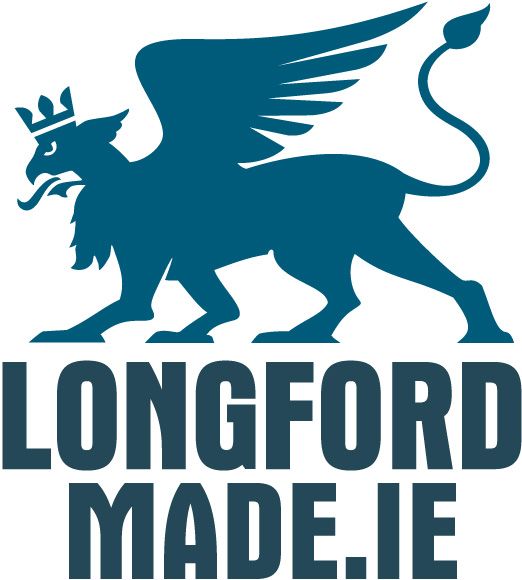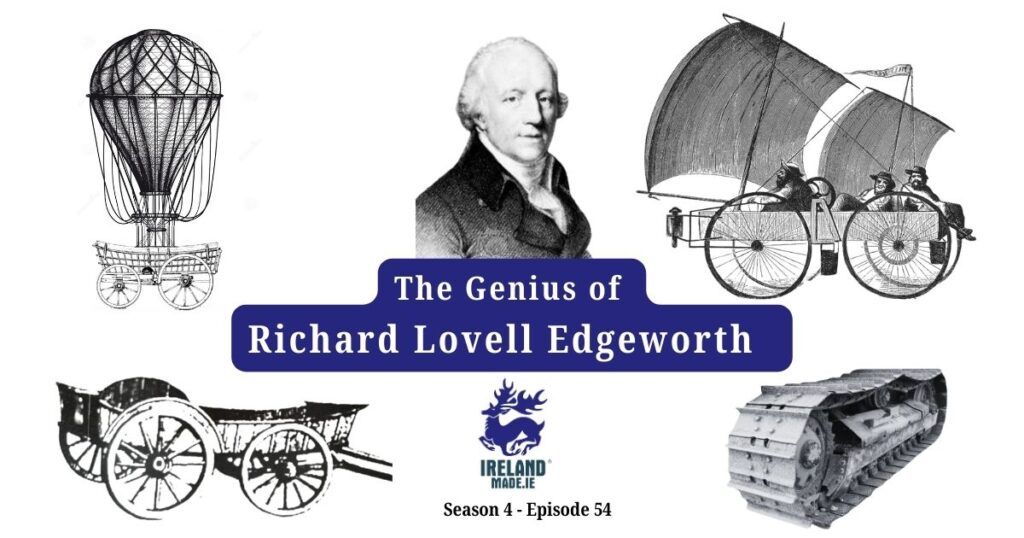
Transportation Inventions of Longford Man Richard Lovell Edgeworth (1744–1817) | Season 4 – Episode 54
Floats, Wheels Jul 23, 2024
“Not a lot of people know that.” This phrase is attributed to the actor Michael Caine’s tendency to share obscure and interesting facts he has gathered over time. In this episode we are bringing interesting transport inventions from the mind of Richard Lovell Edgeworth from the world epicentre of transport innovation, Edgeworthstown in County Longford – not a lot of people know that!
The Ireland Made team recently travelled to the Maria Edgeworth Centre, to hear at first-hand how the inventions of a local man influenced transportation across the globe. Our guide for the day was Matt Farrell a member of the Edgeworth Society and the Volunteer Manager of the Maria Edgeworth Centre at Edgeworthstown, County Longford.

EDGEWORTH FAMILY
Richard Lovell Edgeworth (1744 – 1817) was a descendant of an English family who were granted lands in County Longford by King James the First in 1619. The Edgeworth family lived at Edgeworthstown House, in the village of the same name also known as Mostrim (Irish: Meathas Troim).
RL Edgeworth was regarded as an unusual and excentric man and while he studied law his main interest in mechanics. Around 1813 while at university in Oxford he was fortunate to meet Erasmus Darwin (Charles Darwin’s grandfather) and they shared an interest in horse-drawn carriages and engineering. This then led to Edgeworth being introduced to a group who were considered the founding members of the industrial revolution. The group included the Scottish inventor and engineer, James Whatt who perfected steam engines, devised ‘horsepower,’ as a measurement and created a rev counter, his business partner and foundry expert, Matthew Boulton, Joseph Priestley, the discoverer of oxygen and Josiah Wedgwood, leader in the industrialisation of the manufacture of European pottery.
RIVER RHÔNE
Edgeworth was feeling pressure within his first marriage to Anna Maria Elers as he had fallen in love with Honora Sneyd who was to become his second wife. In a bid to resist his temptations, in 1771 he took up a role in France and was employed on a major engineering project near Lyons to divert the River Rhône. The issue with the Rhône was that it was common practice to remove the silt from the riverbed and pile it up on the riverbanks, so that when the rains came the silt washed back into the river. Edgeworth devised a machine that towed bins suspended on ropes to carry the silt away from the riverbank.
SAIL POWERED CARRIAGE
The invention that brought him into contact with Erasmus Darwin was the invention of a (horseless) carriage that could run on the road and be powered by a sail. While the invention was an undoubted success, the British government banned it for obvious safety reasons.
CARRIAGE SPRINGS
Edgeworth’s main interest was in efficiency for his country estate in County Longford. He felt that carriage springs played an important role in the manufacture of carriages and the more efficient the spring was the bigger the payload they could carry and less work the animal (horse) had to do in pulling the cart.
ROAD PLANNING
From his work on springs, he progressed to designing the roads that his carriages were going to run on. As Matt Farrell outlined and which you can see for yourself on your next visit to Edgeworthstown you will see the two sweeping turns on the road coming into either end of the town. Taking a role as a town planner, Edgeworth designed his roads so that the horse-drawn carriages approaching the town would traverse a wider gradient on approach, rather than a sharp turn.
BOG VEHICLES
In early 1810 Edgeworth was appointed to the Bogs Commission set up by the British Government to explore could they achieve economic value from Irish bogland. Sitting on the commission, Edgeworth surveyed 10,000 acres of bogland in the midlands. In his final report Edgeworth could confidentially claim that the development of the Irish bogs was not only practicable but was economically viable and offered important employment prospects for the impoverished population of Ireland. He also included in his report his designs for several machines that could be used extract resources from the bog.
Matt Farrell outlined one of his bogland designs which was a rail-track and carriage which could be used for removing the peat from the bog. It was worth remembering that at this time steam trains had not been invented and this rail mounted vehicle had to be pushed manually. Matt went on to say that; “over one hundred and twenty years later, Bord na Móna (“The Peat Board”) adopted Edgeworth’s rail design of “frames” (prefabricated track) and load bearing logs when building their 3ft bog railway for extracting at one time up to five million tons of peat annually from the bogs.
THE MACHINE THAT RAN ON ITS OWN ROAD
What a lot of people may not know is that in 1787 Richard Lovell Edgeworth invented, patented and had in use the forerunner of what we now know as caterpillar tracks. Edgeworth had described his design as “the machine that ran on its own road”. In 1810 he claimed to have used his machine to convey a large quantity of stone three-quarters of a mile. His machine design consisted of several sleepers that were joined together, and the machine ran on the sleepers and as it ran forward it pulled the sleepers behind over the top of the machine and back onto the bog so that the machine could drive forward.
EDGEWORTH VS. MCCADAM
When you are driving along the roads you are driving on a surface we commonly known as “macadamisation”. And according to Matt Farrell, if “fair was fair” you should be driving on a road that was called an Edgeworth as in 1813 he published his “An Essay on the Construction of Roads and Carriages” as he had designed a system for the construction of roads which involved using different sizes and types of aggregate that when rolled into the ground formed a solid surface.
Unfortunately, RL Edgeworth did not patent his design and in what can only be a strange coincidence, seven years later in 1820 Scottish engineer John McAdam used Edgeworth’s ideas to develop his system and he has since gone down in history as the man who developed the most efficient roads! In his conversations with an engineer that works in the local council, Matt was told that they had gone back from McAdams design of road, to Edgeworth’s design because it was more efficient to construct.
THE LIST GOES ON..
Over his lifetime Richard Lovell Edgeworth had a long list of other transport inventions including a velocipede (cycle), “perambulator” (land-measuring machine), one-wheeled chaise (light carriage) and a phaeton (a four-wheeled open carriage).
In 1767, Edgeworth invented a mechanical telegraph to relay race results from Newmarket to London, beating the fastest courier and predating the the Frenchman Chappé’s telegraph by twenty years. In 1794, he revived his telegraph idea to alert the government of a possible French invasion of Ireland.
He also designed the first central heating system fitted to a house in Ireland or Britain at Tullynally Castle, Castlepollard, County Westmeath.
Around 1785, following an enlightened discussion with French aviation pioneers, the Montgolfier brothers, Joseph-Michel and Jacques-Étienne, RL Edgeworth did dabble with hot air balloons for a time on his estate, however this new foray did not last long. Although he did design a cart to be suspended beneath a hot air balloon with opening doors on the flatbed that could be used to spread manure on wet bogland he decided to limit his interest in balloons due to ‘the danger of setting the surrounding thatched cottages on fire’. Perhaps he was mindful of the inferno that occurred in the same year in the town of Tullamore County Offaly, when a hot air balloon crashed and set fire to the town. Check out our video-story on the ‘World’s first aviation accident – 1785 Tullamore Ireland”.
AND FINALLY
Edgeworth was an advocate for education and wrote Practical Education in 1798 with his family. The book argued for motivating children to learn at a pace suited to their age and ability, discouraging rote learning. Instead, it recommended using toys to stimulate productive activity through play. Could we lay claim to RL Edgeworth influencing Ole Kirk Christiansen in establishing LEGO in 1934, named after the Danish phrase ‘leg godt’ (‘play well’)?
This August bank holiday weekend, plan your visit to the Maria Edgeworth Centre, Edgeworthstown, County Longford where you will receive a warm welcome and find out all about the unique transport inventions of Richard Lovell Edgeworth.
Information Sources and Photo Credits:
A Brief History of Roadmaking – Roads and those in Tring
Amorous and Airborne Adventures: the Edgeworths in Oxford, Paris, and Dublin – Janine Roder
Bord na Móna
Britannica
Dictionary of Irish Biography
Early lessons (2 vols, London, 1816); Experiments on carriage wheels (Dublin 1817) – Richard Lovell Edgeworth
Erasmus Darwin – Wikipedia Commons
Essay on the construction of wheels and carriages (London 1813) Richard Lovell Edgeworth
MacTar Ltd
Met Museum
National Library of Ireland
Report on district no. 7’ in Second report of the commissioners for improving the bogs of Ireland (London 1810) Richard Lovell Edgeworth
Roadstone
Texas Final Drive
The Man Who Invented Tarmac – SL Driveways
We need your support to travel, record and preserve our transport heritage. Your sponsorship helps keep our history alive. Sponsor our work via www.irelandmade.ie
Your support of just €2 per month allows us to travel and record stories of Irish transport past and present.
There are three ways of supporting us:
Via our website www.irelandmade.ie
Via Facebook https://www.facebook.com/IrlMade/subscribe/
Buy Facebook Stars fb.com/stars
Thank you for your support.
If you have an idea for a story, email Kevin Reid [email protected]

